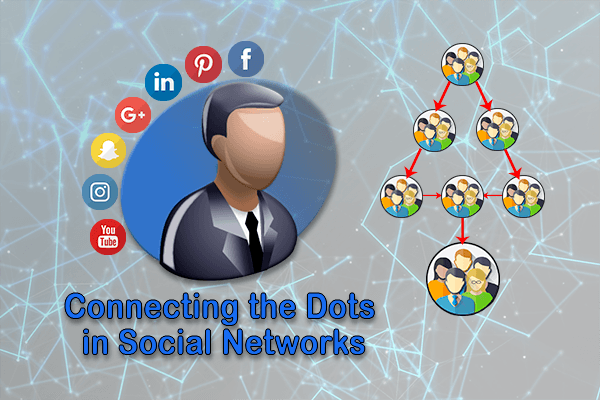Connecting the Dots in Social Networks

What happens when you start searching your person of interest online and learn they have multiple profiles for the same social media site or sites? Are they using an alias profile, or connected to different people than who’s on their main profile? Who are their main connections and where are they posting from?
One thing is for sure, you never know what to expect when investigating someone using social networks. It can lead to more questions than answers at times. To really uncover the facts, you need to know how to connect the “dots” in a person’s social network.
Just because you have identified a subject’s Facebook page, doesn’t mean you are finished and have found all that is out there on the “Open Source Network”. It’s critical not to overlook who your subject is connected to and communicates with on a regular basis. Other key elements to take in mind are: what time of the day are they posting, where are they posting from, where are they checking in at, what events are they invited to, and what interests do they share?
These key elements are crucial when trying to connect the dots on the informational highway we know as the Social Networking Community.
Once you have identified each of the connections to your subject and rate which ones are most relevant or consistent, the next step is to start exploring those connections to see if you can find any new information about your subject. Let’s say your subject has a profile that is completely locked down. All comments, postings, and pictures are set to private. While we aren’t going to hack the account (that’s illegal), we definitely are not going to send them a friend request (that’s just not a smart decision for many reasons), what we can do, is look at our date of loss and injury. Then start going through all the subject’s relevant friends and family that have profiles. BAM!! You just found an open profile of one of the subject’s associates that they communicate with most frequently on social media. She has numerous posts and comments about the subject’s injury, and what she has been doing and involved with since the date of loss. This information would never have been identified if we hadn’t gone through and connected all the “dots”.

Let’s say, for example, you have a liability claim related to a huge fire loss, and you are trying to locate any possible witnesses that may have seen the actual fire, know someone that did witness the incident, who was involved, or possibly uncover conversations between the claimant, family, or friends revealing new information. You don’t always have to tie your-self down to a specific person. Through various open source networking sites, communities, and key word searches, you can also search for specific dates, comments, photos, and pictures that may reveal who was involved, and possibly uncover conversations between the persons involved or locate people that may have driven by the scene, even family, or friends that reveal new information.
Identifying any possible witnesses requires the ability to probe, search, and canvas all social media posts, pictures, comments, and forums related to the incident or situation based on geographic locations and time frames.
Searching through various profiles, locations, events, and dates make it possible to identify who was involved, what occurred at that time, and what everyone remembers through their online conversations.
It’s not unusual for people to forget important details of an incident immediately after they occur, only later to recall more details after the initial shock of the incident is over, and then share those details on social media, or with an associate that will in-turn share the comment on social media.
Every situation will be different and will affect how the investigation is handled. Knowing how to connect the dots through social networks, communities, and other open source media can and will reveal new information. You just need to conduct your investigation methodically, and leave no stone unturned.
IMPORTANT NOTE:
The tips and information provided in this article is for educational purposes. If you are going to perform a social media search on a person of interest, make sure you are following all rules, regulations, and privacy policies associated with these sites. If the accounts and information is not protected by use of privacy setting or restricted profiles of the user, that information is considered publicly available information as long as it’s available to anyone.
